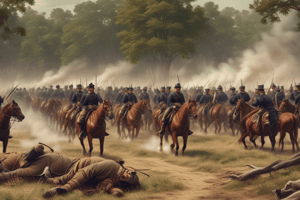Podcast
Questions and Answers
When did Johnston surrender Southern arms to Sherman's terms?
When did Johnston surrender Southern arms to Sherman's terms?
- March 15, 1865
- April 26, 1865 (correct)
- April 9, 1865
- May 3, 1865
Which battle took place just before the surrender at the Bennett Place?
Which battle took place just before the surrender at the Bennett Place?
- Battle of Bentonville (correct)
- Battle of Vicksburg
- Battle of Gettysburg
- Battle of Antietam
Why was the Battle of Bentonville quickly covered as the war drew to a close?
Why was the Battle of Bentonville quickly covered as the war drew to a close?
- It led to the fall of the Union forces
- It happened in the midst of the Confederacy's breakdown (correct)
- It marked the largest troop surrender of the American Civil War
- It was a significant victory for the Confederacy
Which army gave up to Grant just three weeks after the Battle of Bentonville?
Which army gave up to Grant just three weeks after the Battle of Bentonville?
What was the impact of the surrender at Bennett Place on the history of the Civil War?
What was the impact of the surrender at Bennett Place on the history of the Civil War?
What was the initial reaction of Northern newspapers to Sherman's fight with Johnston?
What was the initial reaction of Northern newspapers to Sherman's fight with Johnston?
Why did peace return to Bentonville after the Battle of Bentonville?
Why did peace return to Bentonville after the Battle of Bentonville?
'The remote community enjoyed a quiet obscurity' after what event?
'The remote community enjoyed a quiet obscurity' after what event?
'Long stories of the fighting by war writers followed' which significant event?
'Long stories of the fighting by war writers followed' which significant event?
Where did Joseph E. Johnston give up Confederate arms?
Where did Joseph E. Johnston give up Confederate arms?
Flashcards are hidden until you start studying
Study Notes
Battle of Bentonville
- The Battle of Bentonville took place on March 19-21, 1865, during the American Civil War.
- General Joseph E. Johnston set up his soldiers in a hook shape at Cole's Plantation, blocking the road to Goldsboro.
- General William T. Sherman's army from the North accidentally walked into the trap, but a test attack by the Northern soldiers failed, and the Southern soldiers launched a big assault.
First Day of the Battle
- The Southern soldiers drove the XIV Corps division from General William P. Carlin from the field.
- Morgan's division managed to stay despite being surrounded on three sides by enemy soldiers.
- The Left Wing's XX Corps defended the Morris Farm, stopping the Southern advance.
- The fighting ended with no clear winner.
Second Day of the Battle
- Sherman's Right Wing began arriving on the battlefield, causing sharp fighting as the Southerners changed positions.
- The joining of Sherman's split army placed nearly 60,000 Northern soldiers against Johnston's 16,000 infantry and 4,000 cavalry.
Third Day of the Battle
- Johnston held a weak position, guarding his army's only way to escape over the flooded Mill Creek.
- Sherman's Right Wing moved within a few hundred yards of the left half of Johnston's army.
- A "little look-see" by General Joseph A. Mower's XVII Corps division grew into a full push toward Mill Creek Bridge.
- A Southern counterattack led by Lieutenant General William J. Hardee forced Mower's men back.
Aftermath of the Battle
- Johnston's tired troops left their works during the night and withdrew toward Smithfield.
- Northern forces chased the leaving Southerners as far as Hannah's Creek.
- Sherman occupied Goldsboro, which was crucial to his army's needs.
- The armies of Sherman, Schofield, and Terry came together in Goldsboro and stayed for two and a half weeks.
- On April 26, 1865, Johnston surrendered to Sherman's terms at the Bennett Place near Durham, marking the largest troop surrender of the American Civil War.
Studying That Suits You
Use AI to generate personalized quizzes and flashcards to suit your learning preferences.




